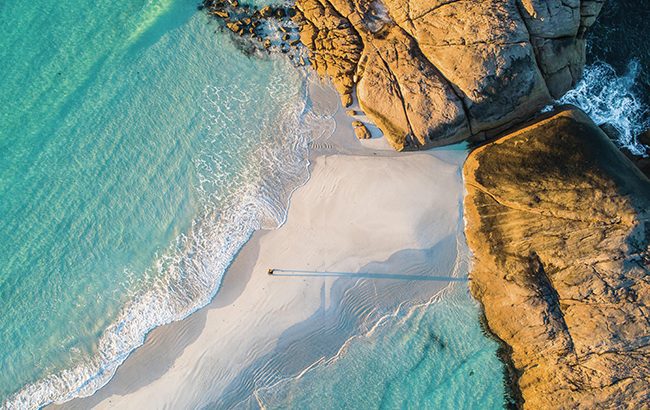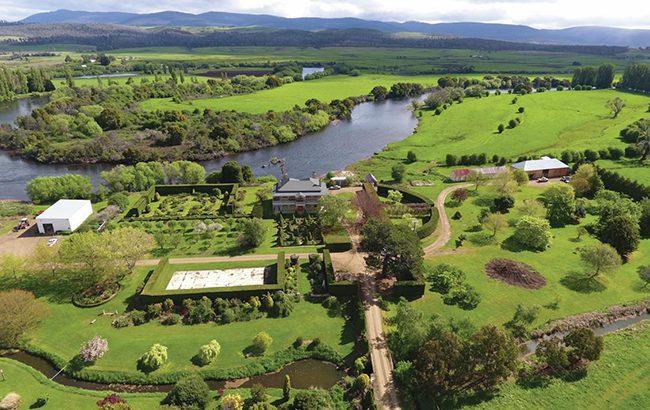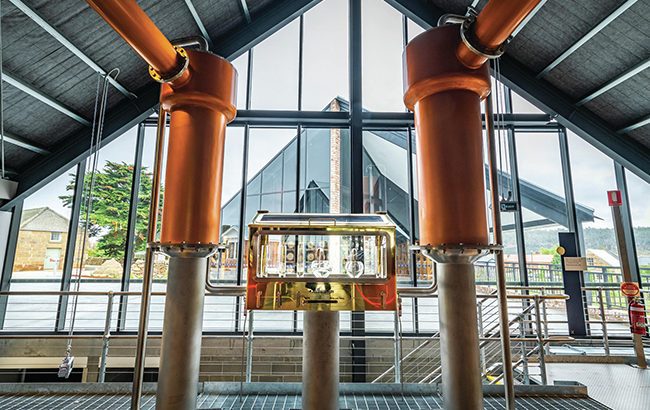Australian whisky eyes export growth
There is a real buzz about Australian whisky and producers are excited about the potential of export markets.

*This feature was originally published in the January 2023 edition of The Spirits Business magazine.
It is just over 30 years since Bill Lark fired up a pot still and began making whisky in his kitchen in Tasmania. It marked the rebirth of Australian whisky, which was first distilled legally in 1822 in the island’s capital of Hobart. By 1838 there were 16 licensed distilleries in Tasmania, but then distilling was banned.
“Sydney was starving, and we were ordered to stop using the barley for grog because they needed it for food,” says Lark. This time there is no stopping the island’s whisky industry, which, after a slow start, has accelerated dramatically in the past few years.
Cam Brett, president of the Tasmanian Whisky & Spirits Association, founded the Spring Bay distillery with his wife, Suzy Brett, in 2015, when there were just seven others. “There are now about 80 distilleries in Tasmania, and 35 of them have a whisky on the shelf,” he says. While some will stick to producing gin and vodka, it is still a huge leap.
“We’re coming in for some very exciting times. We’ve really come of age, in my opinion,” says Lark, dubbed the godfather of Australian whisky, and now global ambassador for the Lark distillery. His enthusiasm was fuelled by a September trip to the UK, and Whisky Live in Paris, where he found “tremendous interest in Tasmanian whisky, and what that’ll do is put us on the international scene properly”.
Growing pains
That said, many of the island’s distilleries are too small and too young to contemplate exports just yet. Overseas, people “are aware of Tasmanian whisky, they just can’t get it”, says Lark. Back home, the sheer number of people jumping on the whisky bandwagon is causing “significant growing pains”, says Cam Brett, who is charged with the unenviable task of trying to establish a legal definition for the category. “It’s certainly the biggest headache I’ve got as president,” he says.
According to Lark, Tasmanian distillers have followed two paths. “If you set up in a tourist area and are happy to sell to local customers at full retail mark‐up, you can have yourself a very nice life,” he says. The alternative is to pump up the volume and go to a much wider audience.
“There are now a number of distilleries that are producing 300,000-400,000 litres per annum [LPA], and there are probably three or four that are looking to make more than one million LPA in the next five years,” he says.

David Vitale, who founded the Starward distillery in Melbourne 15 years ago, doesn’t quite buy the idea that there’s one path for the ‘lifestyle distiller’, and another for the commercial operator in Australia. Speaking of Bill Lark, he says: “He had no intention of making an internationally acclaimed whisky, it just kind of happened that way. If you’d asked William Grant when he was setting up Glenfiddich, it probably wasn’t with an eye to international markets.”
Starward is currently the dominant player in exports, with a share of more than 50%, according to Vitale. Now based in Seattle, he says Starward’s current production is “just shy of a million LPA”. When asked how much US consumers are aware of the category, he replies:
“There’s an awareness of whisky coming from other places. Obviously, no one’s walking into a retail outlet looking for Australian whisky, but they’re definitely going to that section of the store.” He believes the growing interest in US single malts in America has helped stimulate awareness, and says: “I have a theory that a strong domestic whisky‐making market supports other new world whiskies.”
Not that it happens overnight. “In any market you go into, you always feel like you’re spinning your wheels for the first three years, and you get no traction until, at some point, the rubber hits the road,” he says.
Starward is unique in having outside backing from Diageo via its Distill Ventures offshoot, which invested an undisclosed sum in 2015 just after its first such investment in Denmark’s Stauning distillery.
Vitale describes the involvement as twofold. “The first is obviously as an accelerant with access to capital to scale the brand, which is something we’re really fortunate to have. They [Diageo] are not necessarily opening doors for us. That’s not the nature of the agreement, and quite often the relationships they have and the relationships we have are very different. What they are, though, is the coach in the corner, giving us insights, and allowing us to accelerate with fewer speed bumps along the way.”
Tax leveller
Price can be an issue, however. “Working in the US with its very low taxes, the gap between a very decent Scotch whisky and Starward is almost double,” he claims. “In Australia it might be 5%-10%, so in a perverse way the tax system acts as a leveller, as it gives domestic consumers the chance to say ‘for an extra 10 bucks, I’m going to choose the Australian’.”
Meanwhile, sales are reportedly growing strongly in the UK, Germany, and especially in France. “At the moment we’re 65% domestic and 35% export, but within the next five years it’s more than likely going to be the other way round,” Vitale says. Sullivans Cove has been exporting since the early 2000s.
However, notes marketing manager Jerome Lebel‐Jones: “While we have a high level of international interest, we don’t have enough stock to export in a meaningful way. We maintain a presence in a handful of ultra‐premium on‐premise venues in a few international markets, as well as a few retailers in France, the UK and the US. Export accounts for less than 7% of sales.”

Back in Tasmania, a new entrant on the scene is Callington Mill, founded by John Ibrahim, and boasting a 500,000 LPA capacity. “We are only a start‐up distillery, with limited matured whisky available,” he says.
“We know first‐hand that Tasmania makes excellent single malt whisky to be proud of on the world stage. I ‘feel’ that there is great world demand for Tasmanian single malt but I’m not in a position to ‘know’. However, we will eventually find out.” It is early to think of foreign markets, but that’s Callington’s ambition.
“The Tasmanian brand is well known and well received in many countries, especially in our back yard he says. “We intend to export into China, Taiwan, South Korea, Singapore, Hong Kong, and Japan.” Lark says: “There is a little bit of nervousness about some of these big distilleries and what impact they’ll have on the smaller ones. My daughter has her own craft distillery, and my son was running a small one, and I think they have nothing to worry about.”
So far, the big outside investment story remains Diageo; other multinationals, brewers and wine corporations have yet to pounce. “But I know there are a lot of bigger companies sniffing around, having seen the success of the Australian whisky industry,” he says.
Ibrahim believes Tasmania should welcome outside investors. “If we don’t want ‘foreign’ investment then we as Australians should fill that void commercially,” he says. “We should invest and scale our whisky offer to compete on the world stage – not complain about it or seek outdated and inefficient policies of protectionism or isolationism.”
Meanwhile, in Tasmania’s central Highlands, Jensen Farley, co-founder of the farm‐based Lawrenny distillery, believes the island’s whiskies share a certain style “that can be identified as a common thread from many of the producers. This is spirit that can be described as weighty on the palate, lots of length, and often graced by some signature fruit notes. For example, one of our new make spirits has a brilliant nectarine note to it,” he says.
“I think the similarities that can be drawn from the spirit being produced in Tasmania is the use of similar geometry stills, long ferments and quality ingredients such as barley and barrels.”
All that is missing is a legally binding definition.
A defining issue
“Healthy competition, coupled with a legal framework of what defines Tasmanian whisky, is the key to Tasmania becoming a major whisky global player,” says Callington Mill’s John Ibrahim. He wants a legal definition to be imposed “immediately”, but it hasn’t happened yet.
“Part of the problem is that as our industry’s got bigger, there are a few more opinions as to how it should be defined,” says Bill Lark. “It is driving me mad it’s taken so long, but it’s something our association (Tasmanian Whisky & Spirits Association, TWSA) is dedicated to achieving as soon as possible.” TWSA president Cam Brett says: “We have agreed a set of rules, but the difficulty is we can’t police them. The biggest stick we’ve got is to write a stern letter.”
Among options being explored are to follow the wine industry and set up an appellation system, or create a protected trademark, which is “a faster route, but quite a difficult legal process”, he says. Australian lawmakers have tended to view definitions based on location as ‘anticompetitive’ – something the Italians discovered when they tried and failed to protect ‘Prosecco’ Down Under. The broad definition of Australian whisky is: “A fermented grain mash that is distilled and aged in wood for a minimum of two years.”
This would make it a ‘spirit drink’ in the EU and UK, where the minimum maturation is three years. But despite this, Starward founder David Vitale, a self‐confessed “free‐market libertarian” on rules, loves its simplicity, and says: “In my mind it makes Australia the most exciting whisky‐making country in the world.”
Related news
Top 10 spirits for gifting this summer
